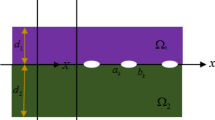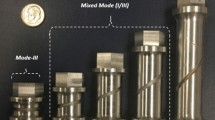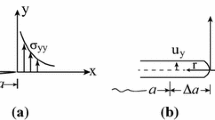Abstract
An experimental study has been conducted to investigate the initiation, propagation, and arrest of bimaterial interface cracks subjected to controlled stress wave loading in the form of a tensile dilatational stress wave pulse. The tensile pulse is generated by detonating lead azide explosive in a specially designed specimen. Dynamic loading of the bimaterial interface results in crack initiation, propagation, and arrest, all in the same experiment. This failure event is observed using photoelasticity in conjunction with high speed photography. Full field data from the experimentally obtained isochromatic fringe patterns is analyzed to determine time histories of various fracture parameters such as the crack tip speed, the dynamic complex stress intensity factor, the energy release rate, and the mixity. The experimental data is also used to quantify the values of the dynamic initiation and arrest toughness and to evaluate a recently proposed dynamic interface fracture criterion.
Similar content being viewed by others
References
J.W. Dally and D.B. Barker, Dynamic measurements of initiation toughness at high loading rates. Experimental Mechanics 28 (1988) 298–303.
X. Deng, General crack-tip fields for stationary and steadily growing interface cracks in anisotropic bimaterials. Journal of Applied Mechanics 60 (1993) 183–189.
J. Lambros and A.J. Rosakis, Dynamic decohesion of bimaterials: Experimental observations and failure criteria. International Journal of Solids and Structures 32,No. 17/18, (1995a) 2677–2702.
J. Lambros and A.J. Rosakis, Shear dominated transonic crack growth in bimaterials, Part I: Experimental observations. Journal of Mechanics and Physics of Solids 43,No. 2, (1995b) 169–188.
J. Lambros and A.J. Rosakis, Development of a dynamic decohesion criterion for subsonic fracture of the interface between two dissimilar materials. Proceedings of the Royal Society (London) A451, (1995c) 711–736.
K.M. Liechti and Y.S. Chai, Biaxial loading experiments to determine the interfacial fracture toughness. Journal of Applied Mechanics 58 (1991) 680–687.
K.M. Liechti and W.G. Knauss, Crack propagation at material interfaces: I. Experimental technique to determine crack profiles. Experimental Mechanics 22 (1982a) 262–269.
K.M. Liechti and W.G. Knauss, Crack propagation at material interfaces: II. Experiments on mode interaction. Experimental Mechanics 22 (1982b) 383–391.
C. Liu, J. Lambros and A.J. Rosakis, Highly transient elastodynamic crack growth in a bimaterial interface: Higher order asymptotic analysis and optical experiments. Journal of the Mechanics and Physics of Solids 41,No. 12, (1993) 1857–1954.
C. Liu, Y. Huang and A.J. Rosakis, Shear dominated transonic crack growth in bimaterials, Part II: Analytical investigation of asymptotic fields and favorable speed regimes. Journal of the Mechanics and Physics of Solids 43,No. 2, (1993) 189–206.
T. Nakamura, Three dimensional stress fields of elastic interface cracks. Journal of Applied Mechanics 58 (1991) 939–946.
R.P. Singh and A. Shukla, Characterization of isochromatic fringe patterns for a dynamically propagating interface crack. International Journal of Fracture 76 (1996b) 293–310.
R.P. Singh, Catastrophic Failure of Bimaterials, Ph.D. Dissertation, Department of Mechanical Engineering and Applied Mechanics, University of Rhode Island, Kingston, RI, 1995.
R.P. Singh and A. Shukla, Subsonic and transonic crack along a bimaterial interface. Journal of Applied Mechanics 63 (1996a) 919–924.
H.V. Tippur and A.J. Rosakis, Quasi-static and dynamic crack growth along bimaterial interfaces: A note on crack-tip field measurements using coherent gradient sensing. Experimental Mechanics 31 (1991) 243–251.
K.C. Wu, Explicit crack-tip fields of an extending interface crack in an anisotropic bimaterial. International Journal of Solids and Structures 27,No. 4 (1991) 455–466.
X.-P. Xu and A. Needleman, Numerical simulations of dynamic crack growth along an interface. International Journal of Fracture 74 (1996) 289–324.
W. Yang, Z. Suo and C.H. Shih, Mechanics of dynamic debonding. Proceedings of the Royal Society (London) A433 (1991) 679–697.
Author information
Authors and Affiliations
Rights and permissions
About this article
Cite this article
Singh, R.P., Kavaturu, M. & Shukla, A. Initiation, propagation and arrest of an interface crack subjected to controlled stress wave loading. International Journal of Fracture 83, 291–304 (1997). https://doi.org/10.1023/A:1007358901588
Issue Date:
DOI: https://doi.org/10.1023/A:1007358901588




